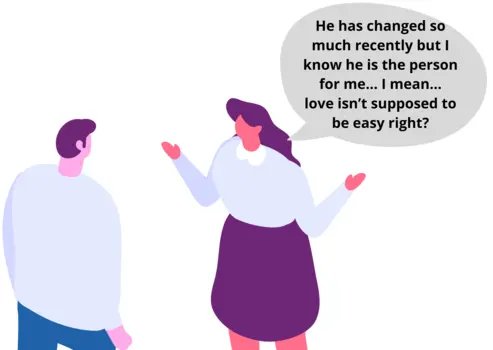One of the reasons that breaking a trauma bond is so hard is because they feel like love. Abusers are so good at blurring the lines between love and abuse and it can make escaping them extremely confusing for victims of abuse. With that being said, learning about the reason why trauma bonds feel like love can turn the confusion into clarity.
Abusers have many powerful manipulative techniques that are designed to make trauma bonds feel like love. The intensity of the abuse that abusers subject their victims to manipulates the victims into a state of mind where they equate the abuse that they’re experiencing with the love that they desire.
In this article you’re going to learn about what love is and then the different manipulative patterns that abusers use to make the trauma bond feel like love in both romantic and family relationships. Again, escaping a trauma bond that feels like love is terribly confusing. So, we’ve outlined our article Can a Trauma Bond Become Healthy in a short video below so that you can have the information needed to feel less confused when escaping a trauma bonded relationship.
A Short Video Explaining Why a Trauma Bonded Relationship Will Never Become Healthy
How Do Abusers Manipulate Their Victims Into Equating Abuse With Love?
According to the Triangular Theory of Love, the three variables that define love are intimacy, passion, and commitment. We’ve written about all of the different types of love in our article Can Narcissists Love but it is widely accepted that consummate love is the ideal/true love for romantic relationships because it consists of all three variables: intimacy, passion, and commitment.
When it comes to the ideal/true love among family members, it is widely accepted that companionate love is the ideal/true love that family members should have for one another. Companionate love only consists of intimacy and commitment and is held together by respect and love, not by the physical attraction that the passion in consummate love.
Abusers are really good at using a very manipulative pattern that consists of mirroring and future faking to manipulate their victims into equating the dynamics of a trauma bonded relationship and the abuse that they’re experiencing with the ideal/true love that is expected from romantic partners and family members.
Mirroring
In abusive relationships, mirroring is when an abuser will absorb a ton of information about their victim’s identity and use that information to create a falsified identity that is designed to fill a void in the victim’s life. In romantic relationships this void is going to be centered around the victim’s perception of the ideal love and in relationships among family members the void is going to be centered around emotional availability, responsiveness, and consistency.
A very common form of mirroring in abusive romantic relationships is a phase called love bombing. This phase is often described as intense, special, unique, and magical by victims of abuse and the reason for this is because the abuser is using mirroring to fulfill the victim’s desire of the ideal/true love. Mirroring and love bombing is all about the abuser being exactly who the victim needs them to be.
With that being said, the love bombing phase isn’t always special, unique, and magical. Sometimes the mirroring that is being done is reflecting or “mirroring” the victim’s unhealthy/abusive upbringing. Meaning that if the victim grew up in a deeply invalidating, devaluing, manipulative, and abusive household, their definition of the ideal/true love is going to be severely corrupted. Which means that they have likely already equated the abusive dynamics of a trauma bonded relationship with love.
When it comes to mirroring between two family members, it is centered around emotional availability, responsiveness, and consistency. This is particularly true when it comes to a parent-child relationship. When children grow up with people who are available, responsive, and consistent, they get the validation, admiration, and reassurance that they need to construct a realistic sense of self.

Due to the bond that family members usually have, all abusers need to do to mirror in family structures is to pretend to be emotionally available, responsive, and consistent and this is often done through the slightest amount of validation, admiration, and/or reassurance.
You see, what mirroring does is it manipulates the victim into thinking that the abuser is someone who can help and inspire them be the best version of themselves and vice versa. It is the versatility of mirroring that allows abusers to make trauma bonds feel like love. It is a powerful technique that can be managed by those who have healthy definitions of the ideal/true love!
Future Faking
When an abuser makes a false premise for the future to get what they want in the present, it is called future faking. There are verbal forms of future faking and there are nonverbal forms of future faking. For example, a verbal future fake would be if an abuser promised a romantic partner or family member that they’d stop drinking and seek out guidance from a therapist if they were given just a little money to get back on their feet. This abuser has no intention of bettering themselves, they just want money to fuel their impulses.
When it comes to nonverbal future faking, it is actually the falsified identity that abusers create through mirroring to manipulate their victim into believing that the abuser is someone who can help the victim become the best version of themselves.
By presenting themselves as the “perfect” person for the victim, they are manipulating them into envisioning a future that is never going to happen. What future faking does is it brings the idea that mirroring manipulates the victim into developing and turns it into something more tangible.
The intensity that mirroring and future faking have blinds the victim from the abusive aspects of the trauma bonded relationship like invalidation, devaluation, dehumanization, and manipulation. They end up equating the abuse that they are experiencing with love because the abuser presents themselves as someone who is meant to be in their life, someone who wants the best for them, and someone who they can be happy and healthy with.
How Are Abusers Able to Make Trauma Bonds Feel Like Love For Months, Years, and Even Decades?
Abusers often make trauma bonds feel like love for months, years, and even decades. The reason for this is something called cognitive dissonance. It is a theory that suggests that when we experience an inconsistency among belief, behavior, and information, it causes a tremendous amount of psychological tension. To ease this tension we will change one or more of the elements that are causing the inconsistency to make everything consistent.
In trauma bonded relationships cognitive dissonance manifests in the form of the justification, rationalization, and normalization of abuse. The reason that this happens is because when an abuser uses mirroring and future faking to manipulate their victim into believing that the abuser is the “perfect” person for them, they give the victim the information and show them the behavior that they need to develop the belief that the abuser is the “perfect” person for them.
Unfortunately, this phase does not last long. In fact, in our article How Long Does the Love Bombing Phase Last (Survey) we discovered that this phase usually lasts five-and-a-half months with narcissistic men and three-and-a-half months with narcissistic women.
Once the abuser senses that they’ve manipulated the victim into attaching themselves to the vision of a happier and healthier future with them, they will drop the act and begin their abusive pursuit of power, control, validation, admiration, and reassurance. This is commonly referred to as the devaluation phase.
What is happening here is the abuser’s sudden shift in behavior is changing the information that they give the victim and the behavior that they show them, leaving them with only the belief that the abuser is the “perfect” person for them. This sudden shift is exactly what triggers cognitive dissonance.

The reason being that the victim is forced to choose between acknowledging that they are in an abusive relationship or holding onto the belief that the abuser is someone who they can grow, be happy, and live a healthy life with.
While it may seem like acknowledgement is the obvious choice, abusers have a ton of different forms of manipulation that are designed to keep the victim in a state of cognitive dissonance.
We spoke about this a lot in our articles Is Breadcrumbing Emotional Abuse and Why Do Trauma Bonds Feel Like an Addiction but one of the most common, and most powerful, forms of manipulation that abusers will use is breadcrumbing, also known as intermittent reinforcement.
Breadcrumbing/intermittent reinforcement is the delivery of a reward at irregular intervals and abusers use it to keep their victims justifying, rationalizing, and normalizing the abuse. What happens is when the abuser senses that the victim is catching on to just how abusive the environment is, they will show compassion and empathy, the “reward” of breadcrumbing/intermittent reinforcement, to regain power and control over them.
It works so well because after all of the mirroring, future faking, and abuse, the relationship is so emotionally starved that the “reward” the victim gets actually triggers the reward center in their brain and floods their body with dopamine, the same neurotransmitter that is released when humans abuse drugs like opiates, alcohol, nicotine, amphetamines, and cocaine.
What this does is it causes the victim to develop an addiction for the relationship. After all the abuse that they’ve experienced, their sense of self has been destroyed and their only known source of happiness has become the “reward” that their abuser gives them.
Over time they end up neglecting their own thoughts, feelings, emotions, and needs, to chase the “reward” of breadcrumbing/intermittent reinforcement. It is the intensity of the manipulation that leads to cognitive dissonance that allows abusers to make trauma bonds feel like love for months, years, and even decades.
What Should You Take Away From This Article?
This article guided you through a very manipulative pattern that is commonly seen in narcissistic relationships and is largely to blame for trauma bonds feeling like love. However, there are many other manipulative behaviors that abusers use to blur the lines between love and abuse. You must educate yourself on each behavior so that you can have the information that you need to stay safe.
Trauma bonds feel like love because abusers put an extraordinary amount of effort into manipulating their victim into believing that they are in a healthy, happy, and loving relationship. The intensity of this manipulation clouds the victim’s mind and bullies them into equating the abuse that they are experiencing into the love that they desire and deserve.
About the Author

Hey, I’m Elijah.
I experienced narcissistic abuse for three years.
I create these articles to help you understand and validate your experiences.
Thank you for reading, and remember, healing is possible even when it feels impossible.
References:
WebMD: What Is Dopamine?
